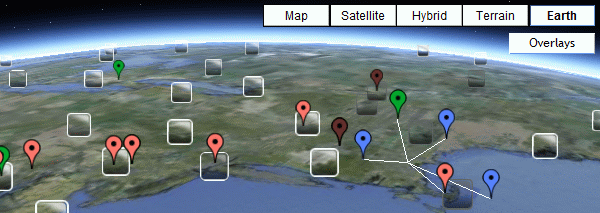During the past two weeks I’ve been putting some effort in making some big changes to the source of Maps and Semantic Maps, and adding some awesome new features. Although not every to-do for the 0.6 release has been completed, I’ve made an early alpha version available which allows you to try out some of the exiting new functionality. So let’s have a look at the most notable changes since 0.5.5.
New features
- Support for various width and height notations. Previously Maps only accepted width and height values is px, forcing you to use maps of fixed sizes. Since most people want to have their complete page width visible even on small screens, this resulted in a lot of people using rather small maps, and so wasting screen space. 0.6 allows you to specify the size in px, ex, em, and most importantly, in %. The syntax is what you’d expect: width=”420px”, width=”420em”, width=”42%”. width=”420″ will default to using px, so is backward compatible. When using the % values, maps will even adapt their size when the screen width or the height of the container they are in is changed after the page has loaded 🙂 See my wiki for some cool examples. Although this is really basic functionality in a way, it’s awesome to finally have it available.
- Added full support for DMS, DD, DM and float coordinate notations, both their directional and non-directional variants. This means you can now enter coordinates in these notations in the display_point(s) and display_map parser functions, as well as make Semantic Maps recognize them as geographical coordinates. Smart geocoding support has also been added to #geocode, meaning you can now pass along coordinates as well as addresses, so you don’t have to double check if your passing along an address to prevent losing the value.
- Coordinate formatting support. Along with the smart geocoding support, #geocode now also accepts 2 parameters to specify the output notation. Since you can pass along coordinates, this means you can change the notation of a set of coordinates using #geocode. A new parser function, #coordinates, has been added specifically for this purpose, so for pure formatting, you should use this one rather then #geocode. Both parser functions work with a hybrid parameter system that supports several ‘default’ parameter (ones that consist of only a value, and no name) and named parameters. You can work with names or without for the default ones, and the default ones in #geocode are the same as the old parameter order, so backward compatibility is retained.
- Rewrote map html and js output. This is now done in a cleaner, safer and more consistent way, for all mapping services in both Maps and Semantic Maps. This is not a new feature, but such a big refactoring it’s worth noting.
More to come…
- Native support for geographical proximity queries in Semantic Maps. This will require quite some work to do in a clean and efficient way, so will probably one of the last features finished for 0.6.
- OpenLayers 2.9 support. Since Maps 0.1, it has been supporting OpenLayers 2.8, and 2.9 is just about to be released, so It’ll be nice to see the progress made there.
On top of these changes to the extensions, I’m drastically redoing the documentation and examples. I’ll post more about that later on though 🙂

